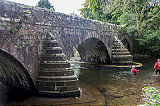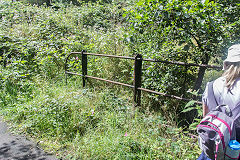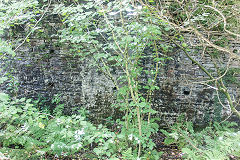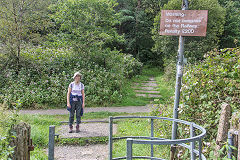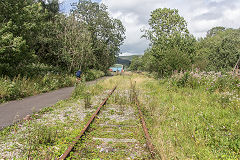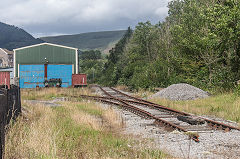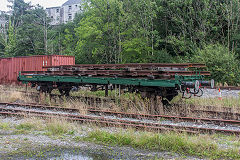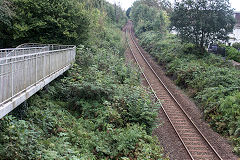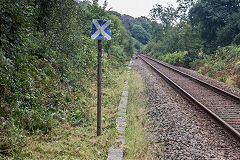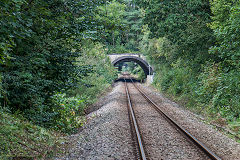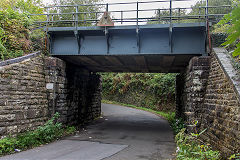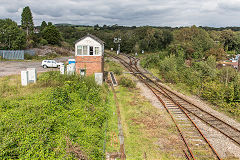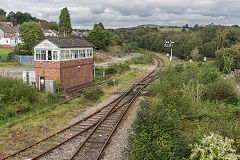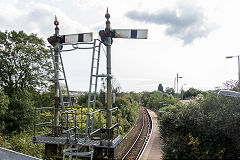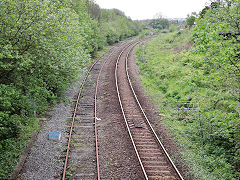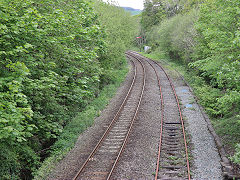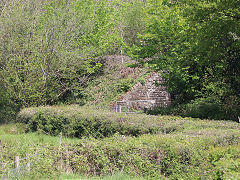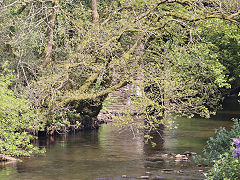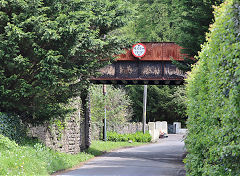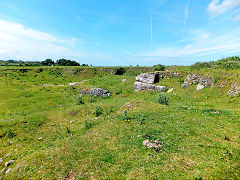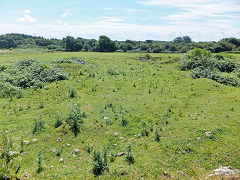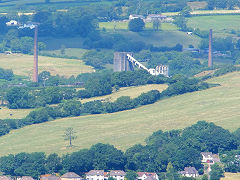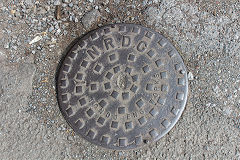The industrial history and archaeology of Cardiff, South and Mid Glamorgan
Click on the button to go to :-
Click on the thumbnail to enlarge a photo or map and sometimes read more about it.
Then click 'Full Size' on the toolbar to see it in all its glory.
'Bridgend Railway' tramroad 1829 - 1854
The Bridgend Railway was a tramroad that connected the Duffryn, Llynfi and Porthcawl Railway with Bridgend town centre running from near Parc Slip Colliery to what is now Bridgend bus station. It was opened in 1830 and It became part of the Llynfi Valley Railway Co (ex DLPR) in 1854 before the new broad-gauge Llynfi Valley Railway was built up the valley.
The Bridgend Railway Junction - SS 8855 8355
From the Duffryn, Llynfi and Porthcawl Railway the tramroad headed South, crossing the Kenfig River on a stone-built bridge, to head into Aberkenfig along the present-day Kenfig Hill to Aberkenfig road.
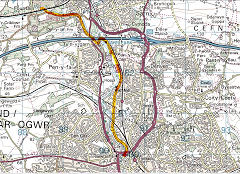
The Bridgend Railway, 1830
|

The Bridgend Railway, 1830
|
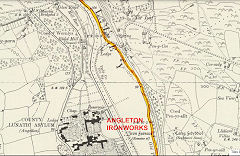
The Bridgend Railway, 1830
|
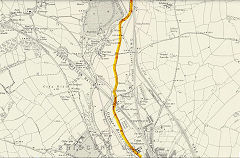
The Bridgend Railway, 1830
|
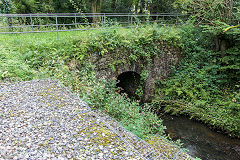
The tramroad at the River Kenfig
|

The tramroad at the River Kenfig
|
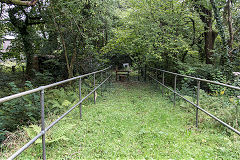
The tramroad at the River Kenfig
|
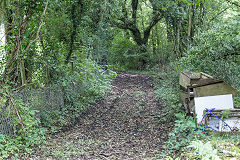
The tramroad at the River Kenfig
|
The Bridgend Railway through Aberkenfig - SS 8943 8330
From Aberkenfig the tramroad heads down Factory Terrace, over another stone-built bridge, and on to Glan-rhyd Viaduct.
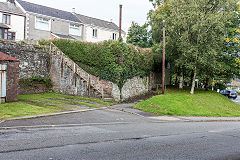
The tramroad at Aberkenfig
|
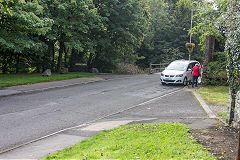
The tramroad at Aberkenfig
|
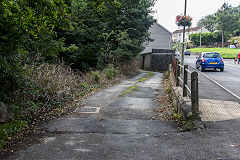
The tramroad at Aberkenfig
|

The tramroad at Aberkenfig
|

The tramroad at Aberkenfig
|
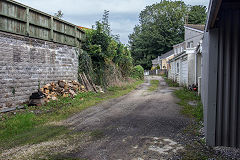
The tramroad at Aberkenfig
|
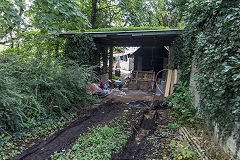
The tramroad at Aberkenfig
|
|
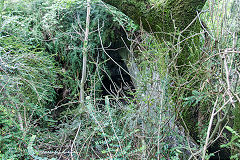
The tramroad bridge at Aberkenfig
|
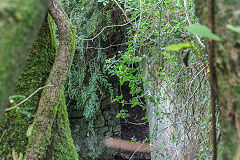
The tramroad bridge at Aberkenfig
|
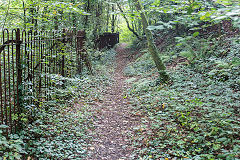
The tramroad to Glan-rhyd Viaduct
|

The tramroad to Glan-rhyd Viaduct
|
Glan-rhyd Viaduct - SS 8989 8279
The Glan-rhyd Viaduct, or Ogmore Viaduct, was built in 1829 and has an inscribed stone plaque, "This bridge was erected in the year 1829 by Morgan Thomas Laleston mason". It s now dwarfed by the M4 motorway which soars above it.
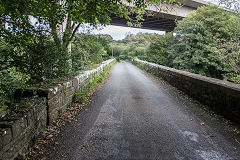
Glan-rhyd Viaduct
|
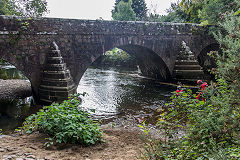
Glan-rhyd Viaduct
|
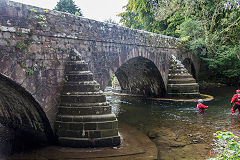
Glan-rhyd Viaduct
|

Glan-rhyd Viaduct
|
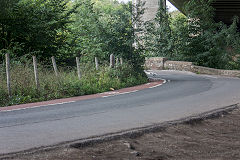
Glan-rhyd Viaduct
|
|
Angleton Iron Furnace - SS 9042 8198
The tramroad runs alongside the Llynfi Valley Railway, which replaced it, to pass the weird ruins of Angleton Iron Furnace. The furnace was built in 1589 by Robert Sidney of Penshurst; this was the only attempt to introduce a blast furnace into central Glamorgan before the eighteenth century. The furnace was still in use in 1600. The two wall foundations are virtually all that remains. The back walls, probably 2.5m high, are formed of thin slabs of sandstone which have a thin coating of slag on the exposed surface. Debris has been heaped against the outer sides and tops of walls. The remains have been held together by the roots of a tree for at least 30 years. Remains of another furnace lie some 80m to the north. (Coflein)

The tramroad on Pen-y-fai Road
|
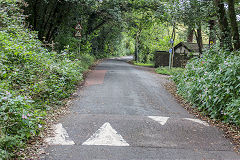
The tramroad on Pen-y-fai Road
|
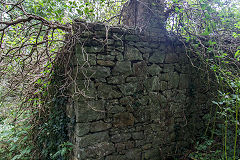
The tramroad on Pen-y-fai Road
|
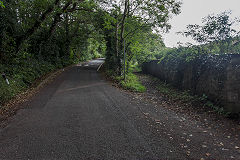
The tramroad on Pen-y-fai Road
|
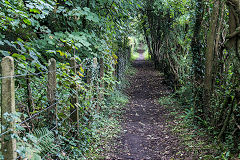
The tramroad beside the railway
|
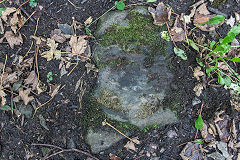
Stone sleepers on the route
|
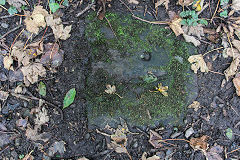
Stone sleepers on the route
|
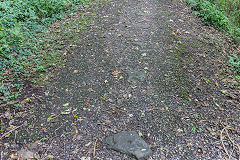
Stone sleepers on the route
|
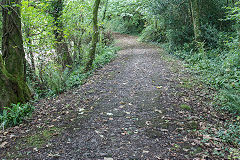
The tramroad beside the railway
|
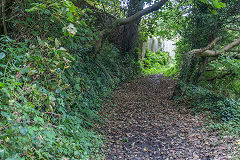
The tramroad beside the railway
|

Angleton Iron Furnace
|
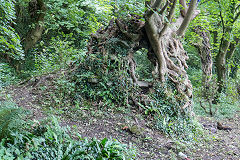
Angleton Iron Furnace
|
The Bridgend Railway through Wildmill
Wildmill is now totally covered in housing but the tramroad can still be traced through the roads and lanes to Quarella Road bridge. From there it ran down Quarella Road into the centre of Bridgend
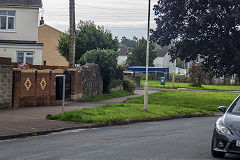
The tramroad at Quarella Road
|
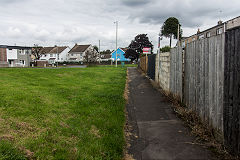
The tramroad at Quarella Road
|
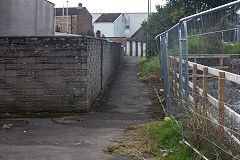
The tramroad at Quarella Road
|
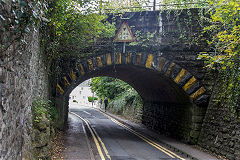
Quarella Road bridge, Bridgend
|
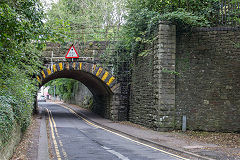
Quarella Road bridge, Bridgend
|
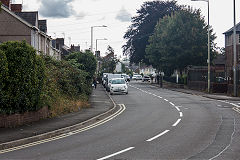
Quarella Road, Bridgend
|
Llantrisant and the Ely Valley
Ely Valley
Upper Penrhiwfer Colliery, near Tonyrefail - SS 9972 8968
Penrhiwfer Colliery commenced operations in 1861 alongside the Ely Valley Railway between Tonyrefail and Penygraig. At some time Upper Penrhiwfer Colliery opened higher up the hillside. This had clay seams and a brickworks appears to have been built here. The Glamorgan Coal Co owned the colliery but it closed down in 1896 when the assets were auctioned.
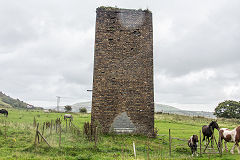
Upper Penrhiwfer Colliery
|

Upper Penrhiwfer Colliery
|
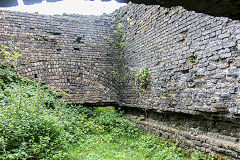
Upper Penrhiwfer Colliery
|

Upper Penrhiwfer Colliery
|
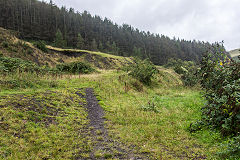
Upper Penrhiwfer Colliery
|
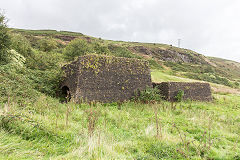
Upper Penrhiwfer Colliery
|

Upper Penrhiwfer Colliery
|
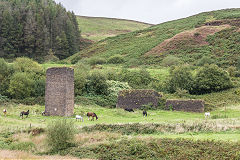
Upper Penrhiwfer Colliery
|

Penrhiwfer Colliery building
|

Penrhiwfer Colliery auction, 4 May 1896
|

Bruce Terrace, Penrhiwfer
|
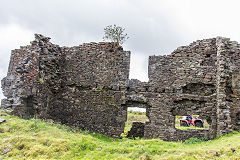
Bruce Terrace, Penrhiwfer
|
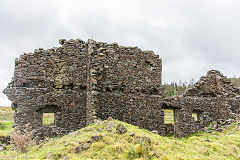
Bruce Terrace, Penrhiwfer
|
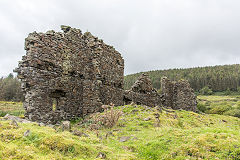
Bruce Terrace, Penrhiwfer
|
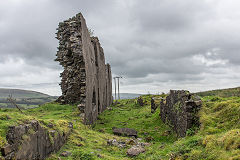
Bruce Terrace, Penrhiwfer
|
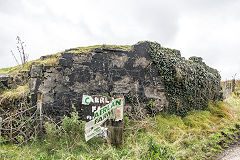
Bruce Terrace, Penrhiwfer
|
Llanharan
Meiros Colliery tramway, Llanharan - ST 0033 8321
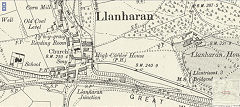
Meiros Colliery tramway, 1897
|
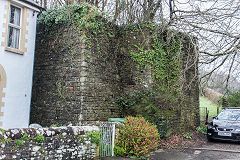
Meiros Colliery branch, Llanharan
|
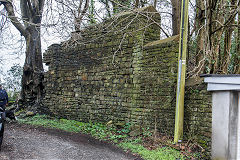
Meiros Colliery branch, Llanharan
|

Meiros Colliery branch, Llanharan
|
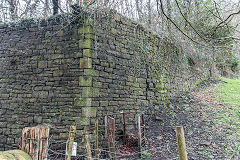
Meiros Colliery branch, Llanharan
|
|
South Rhondda Colliery, Llanharan - SS 9914 8487

South Rhondda Colliery, 1897
|
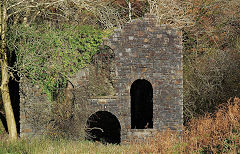
South Rhondda Colliery, Llanharan
|
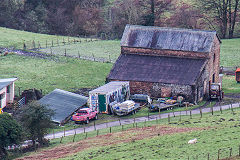
South Rhondda Colliery, Llanharan
|
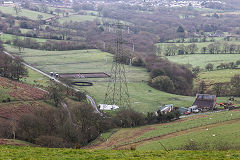
South Rhondda Colliery, Llanharan
|
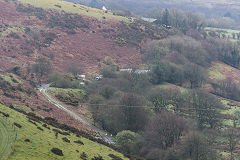
South Rhondda Colliery, Llanharan
|

South Rhondda Colliery, Llanharan
|
Sulphur Springs pipeline, Llanharan - ST 0077 8342
A series of concrete blocks runs up the hillside from Llanharan towards Ffynnon Maelwg, a 'sulphureous' well according to the OS maps. I am guessing that an attempt was made to turn Llanharan into a spa and this was the pipeline from the well to one of the local hostelries, any other ideas are most welcome.
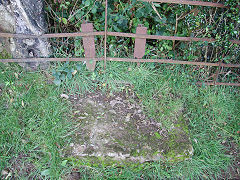
Sulphur Springs pipeline, Llanharan
|
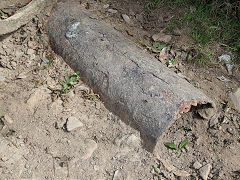
Sulphur Springs pipeline, Llanharan
|
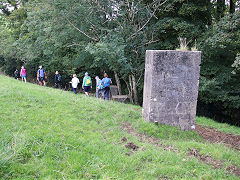
Sulphur Springs pipeline, Llanharan
|
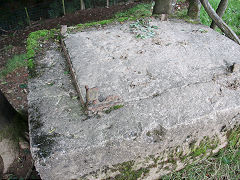
Sulphur Springs pipeline, Llanharan
|
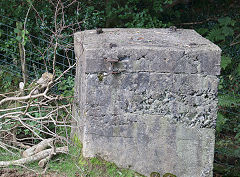
Sulphur Springs pipeline, Llanharan
|
|
Llantrisant Common
Gelynog Colliery, Beddau - ST 0554 8528
Also known as North Llantwit Colliery, Gelynog Colliery was open by 1854. It closed and re-opened under a number of owners until finally closing in 1901. It was connected to a short spur off the Treferig Railway. Recently the site has been used as a bus garage and is now going to be another housing development. The filled shaft is fenced off at the rear.
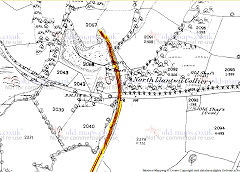
Gelynog Colliery, Beddau, 1876
|
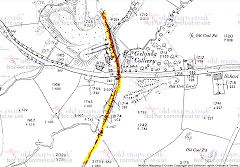
Gelynog Colliery, Beddau, 1899
|
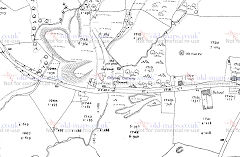
Gelynog Colliery, Beddau, 1919
|
|
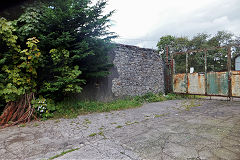
Gelynog Colliery, Beddau
|
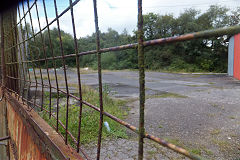
Gelynog Colliery, Beddau
|

Gelynog Colliery, Beddau
|
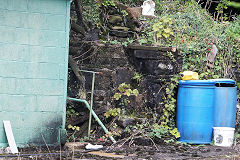
Gelynog Colliery, Beddau
|
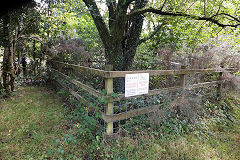
Gelynog Colliery shaft, Beddau
|

Gelynog Colliery, Beddau
|

Gelynog Colliery loading bank
|
|
West Llantwit Colliery, Llantrisant Common - ST 0508 8499
West Llantwit Colliery appears to have been working c1865 and abandoned in 1895. it was connected by tramways to the Treferig Railway South of the colliery, Eastwards to a small building and Northwards to the lane. Aerial photos seem to suggest it might have carried on across the lane to an old shaft at Tal-y-fedw. The capped air shaft is easily found in the workings.

West Llantwit Colliery, 1876
|
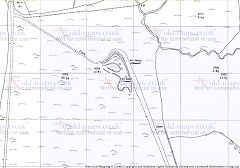
West Llantwit Colliery, 1960
|
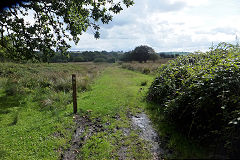
West Llantwit Colliery, Beddau
|
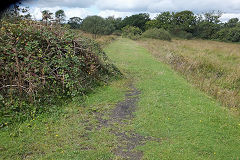
West Llantwit Colliery, Beddau
|
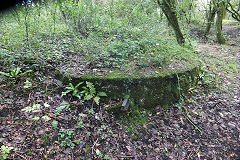
West Llantwit Colliery air shaft
|
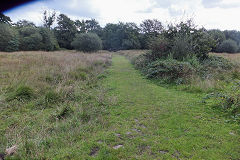
West Llantwit Colliery, Beddau
|
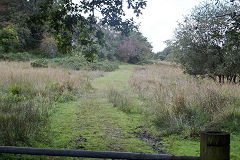
West Llantwit Colliery, Beddau
|

West Llantwit Colliery, Beddau
|
Pontyclun and Cross Inn
Pontyclun Station - ST 0357 8142
Goods yard and along the Coed Ely branch to Mwyndy Junction
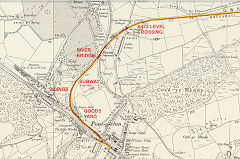
Pontyclun Station area,1898
|
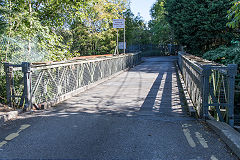
Ely Tinplate Works road bridge
|
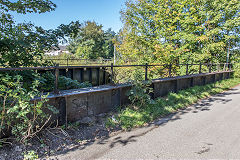
Goods Yard entrance bridge
|
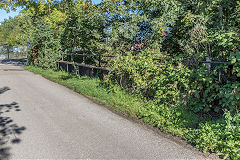
Goods Yard entrance bridge
|
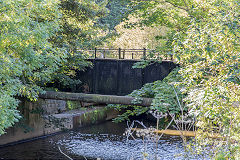
Goods Yard entrance bridge
|
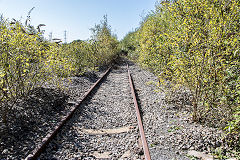
Sidings and shed area, Pontyclun
|
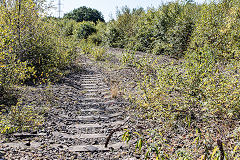
Sidings and shed area, Pontyclun
|

Tramway rail in sidings, Pontyclun
|
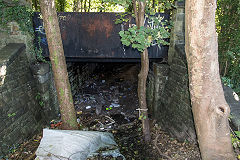
Subway under sidings, Pontyclun
|

Subway under sidings, Pontyclun
|
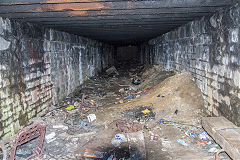
Subway under sidings, Pontyclun
|
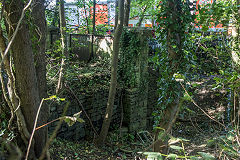
Subway under sidings, Pontyclun
|
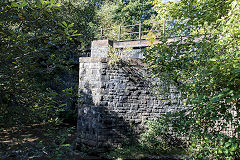
Ely River bridge, Pontyclun
|
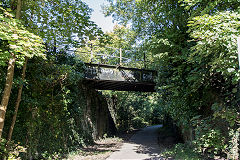
Ely River bridge, Pontyclun
|
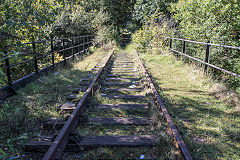
Ely River bridge, Pontyclun
|
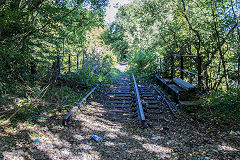
Ely River bridge, Pontyclun
|
Cross Inn - ST 0546 8299
Along the Cwm branch to Talbot Green and the Llantrisant No 1 Ralway
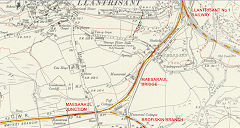
Cross Inn railways,1914
|
|
|
|
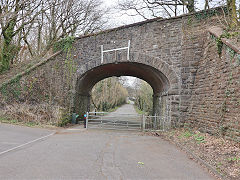
Llantrisant No 1 Railway bridge
|
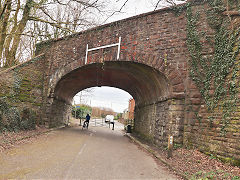
Llantrisant No 1 Railway bridge
|
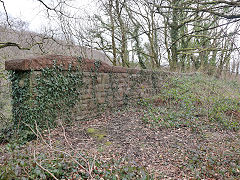
Llantrisant No 1 Railway bridge
|
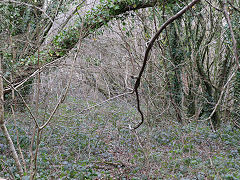
Llantrisant No 1 Railway trackbed
|

Cwm Branch approaching Cross Inn
|
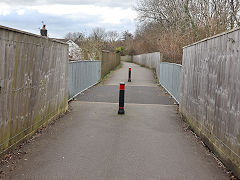
Cwm Branch at Cross Inn
|

Cwm Branch at Cross Inn
|
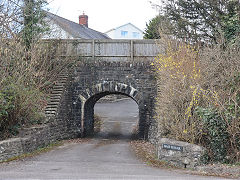
Cwm Branch at Cross Inn
|
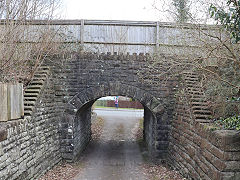
Cwm Branch at Cross Inn
|
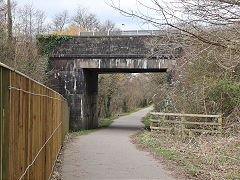
Cwm Branch at Maesaraul Junction
|
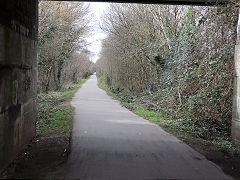
Cwm Branch near Talbot Green
|
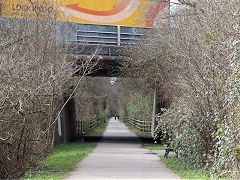
Cwm Branch at Talbot Green
|

Cwm Branch at Talbot Green
|

A473 Level Crossing, Talbot Green
|
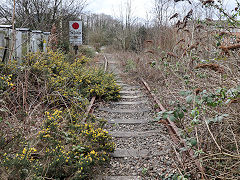
A473 Level Crossing, Talbot Green
|
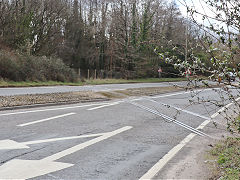
A473 Level Crossing, Talbot Green
|
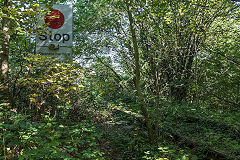
A473 Level Crossing from Pontyclun
|
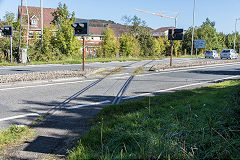
A473 Level Crossing from Pontyclun
|
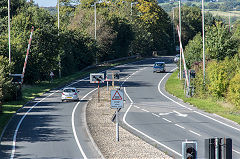
A473 Level Crossing, Talbot Green
|
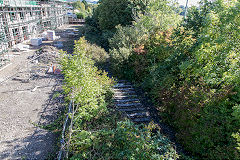
A473 Level Crossing to Talbot Green
|
Kenfig Valley and Cefn Cribbwr
Parc Slip Colliery - SS 8786 8353
Parc Slip Colliery opened in the 1860s by the Brogdens, becoming part of Norths Navigation Ltd. On 26 August 1892 an explosion killed 112 of the 146 men and boys working in the colliery. The site is now part of Parc Slip Nature Reserve.
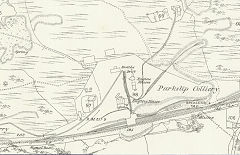
Parc Slip Colliery, 1876
|
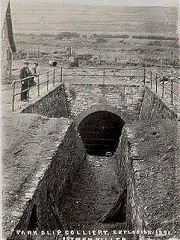
Parc Slip Colliery
|

Parc Slip Colliery dram
|
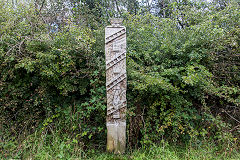
Parc Slip Colliery memorial
|
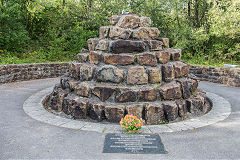
Parc Slip Colliery monument
|
|
Cefn Slip Colliery - SS 8786 8353
Cefn Slip Colliery opened in c1857 to supply coal to Cefn Ironworks. It became the Bryndu Colliery Co Ltd in 1908 but closed in 1912 due to serious water incursion. The colliery assets were auctioned in1915.
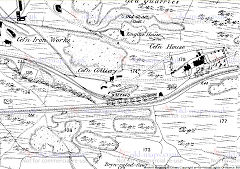
Cefn Slip Colliery, 1876
|
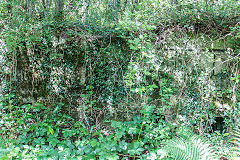
Cefn Slip Colliery
|
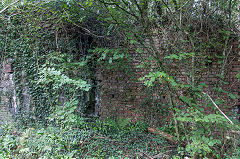
Cefn Slip Colliery
|
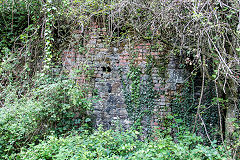
Cefn Slip Colliery
|
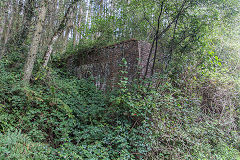
Cefn Slip Colliery
|
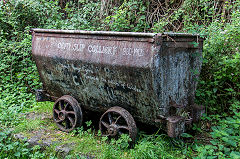
Cefn Slip Colliery dram
|
Cefn Cribbwr Ironworks - SS 8510 8345
Cefn Cribbwr Ironworks is a charcoal-fuelled furnace built by John Bedford of Birmingham, after he acquired the estate in 1771. A high-level charging ramp to the furnace with three calcining kilns, the ruins of the casting-house and a later 1820s beam-engine house survive.
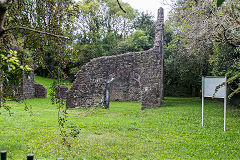
Cefn Cribbwr Ironworks
|
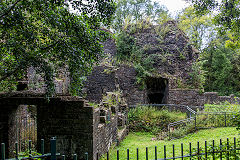
Cefn Cribbwr Ironworks
|
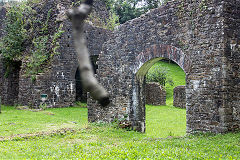
Cefn Cribbwr Ironworks
|
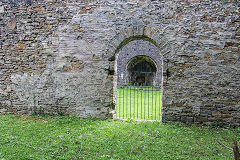
Cefn Cribbwr Ironworks
|
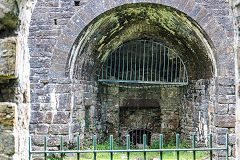
Cefn Cribbwr Ironworks
|
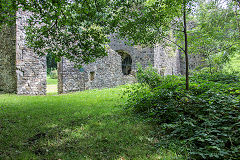
Cefn Cribbwr Ironworks
|
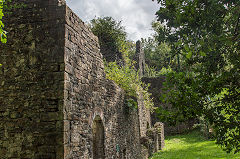
Cefn Cribbwr Ironworks
|
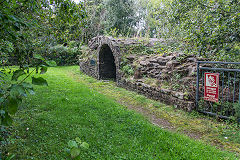
Cefn Cribbwr Ironworks
|

Cefn Cribbwr Ironworks
|
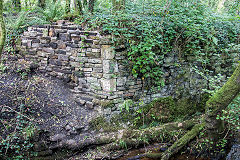
Cefn Cribbwr Ironworks
|
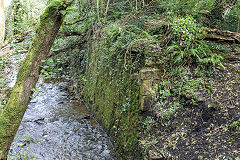
Cefn Cribbwr Ironworks
|
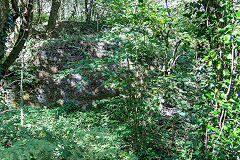
Cefn Cribbwr Ironworks
|
The Dyffryn, Llynfi & Porthcawl Railway
Tondu to Kenfig Hill
The Dyffryn, Llynfi & Porthcawl Railway was built in 1825 and connected Porthcawl Harbour with Maesteg via Kenfig Hill and Tondu. It passed ironworks and collieries on its route to Maesteg. The 4'6" tramroad was converted to a steam railway in 1861. In 1894 the Port Talbot Railway built the Ogmore Valleys Extension Railway from its lines at Margam to meet the DLPR at Cefn Junction.
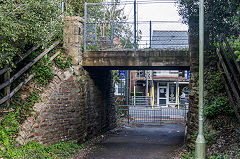
Subway under DLPR, Tondu
|
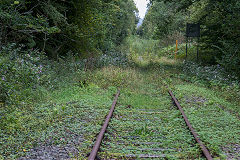
Bridgend Railway crossing
|
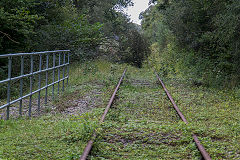
Bridgend Railway crossing
|
|
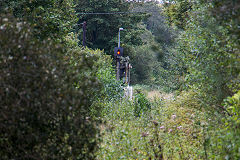
Fountain level crossing, DLPR
|
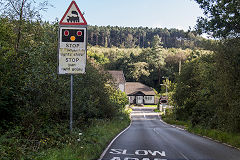
Fountain level crossing, DLPR
|
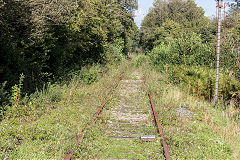
Fountain level crossing, DLPR
|
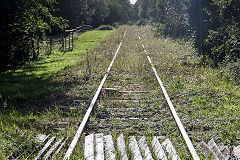
Fountain level crossing, DLPR
|

Cwm Ffos level crossing, DLPR
|
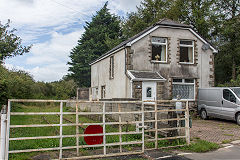
Cwm Ffos level crossing, DLPR
|
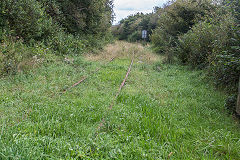
Cwm Ffos level crossing, DLPR
|
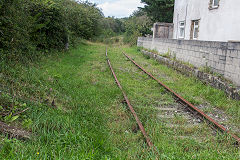
Cwm Ffos level crossing, DLPR
|

Cefn Junction, DLPR
|
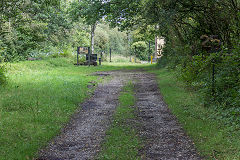
Cefn Junction, DLPR
|
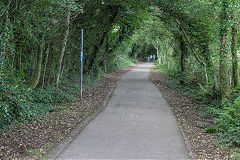
Near Kenfig Hill, DLPR
|
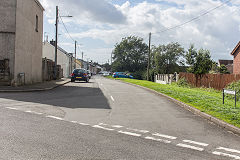
The site of Kenfig Hill Station
|
Cefn Junction signal box - SS 8589 8338
Cefn Junction signal box was built in 1898 to control the junction of the Port Talbot and Porthcawl lines. The Porthcawl line closed c1974 and the signal box became a local museum.

Cefn Junction, 1876
|
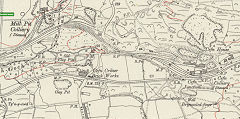
Cefn Junction, 1913
|
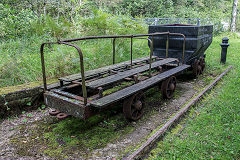
Cefn Junction signal box
|
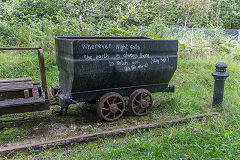
Cefn Junction signal box
|
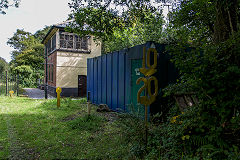
Cefn Junction signal box
|
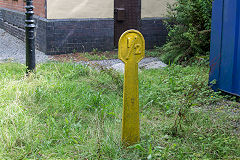
Cefn Junction signal box
|
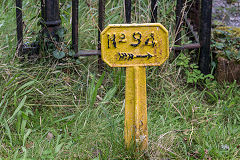
Cefn Junction signal box
|
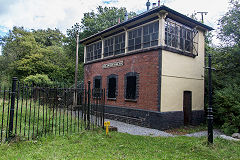
Cefn Junction signal box
|
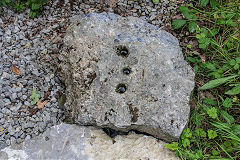
Cefn Junction signal box
|
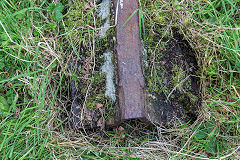
Cefn Junction signal box
|
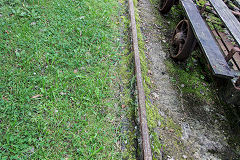
Cefn Junction signal box
|
|
The Ogmore Valleys Extension Railway
Cefn Junction to Pyle
The Ogmore Valleys Extension Railway was bult in 1896 by the Port Talbot Railway from Margam to the new Cefn Junction on the Dyffryn, Llynfi & Porthcawl Railway. The PTR intended to attract the valuable coal traffic away from Porthcawl to its own docks in Port Talbot.
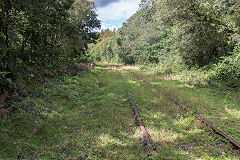
The OVER at Cefn Junction
|
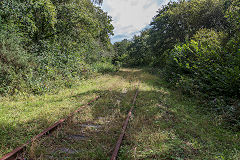
The OVER at Cefn Junction
|
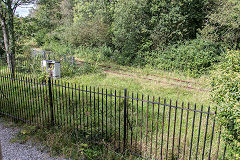
The OVER at Cefn Junction
|
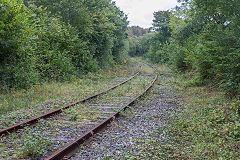
Bedford Road pedestrian crossing
|
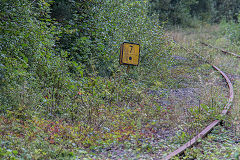
Bedford Road pedestrian crossing
|
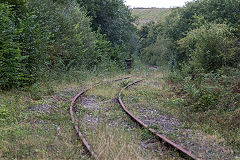
Bedford Road pedestrian crossing
|
|
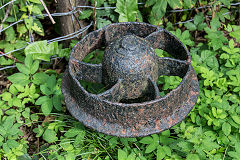
An embedded dram wheel
|
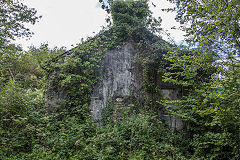
Bedford Road bridge, OVER
|

Bedford Road bridge, OVER
|
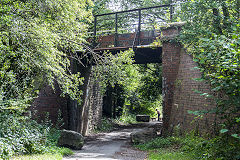
Bedford Road bridge, OVER
|
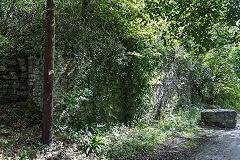
Bedford Road bridge, OVER
|
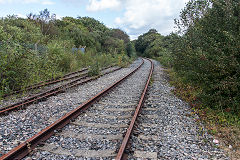
The opencast sidings, OVER
|

The opencast sidings, OVER
|
|
|
Tondu, the ironworks, tramways and industries
Tondu Ironworks - SS 8915 8440
Tondu Ironworks
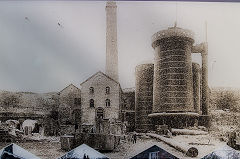
Tondu Ironworks
|
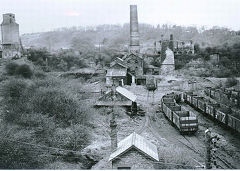
Tondu Ironworks
|
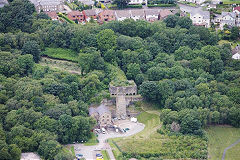
Tondu Ironworks
|

Tondu Ironworks
|
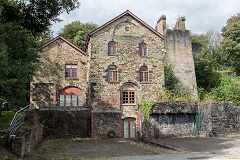
Tondu Ironworks
|
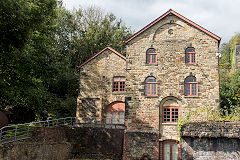
Tondu Ironworks
|
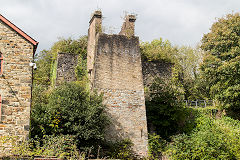
Tondu Ironworks
|
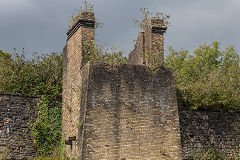
Tondu Ironworks
|
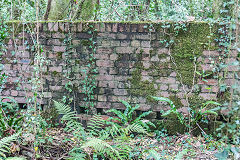
Tondu Ironworks
|
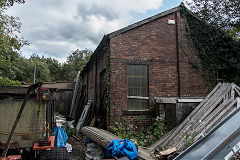
Tondu Ironworks
|
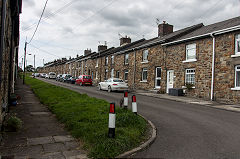
Tondu Ironworks
|
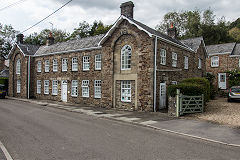
Tondu Ironworks
|
Tondu Ironworks incline - SS 8915 8440
Tondu Ironworks incline ran from the GWR sidings to the coke ovens above the furnaces. The railway to the slag tips ran over the bridge.
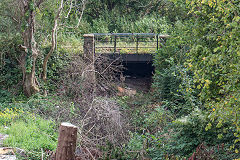
Tondu Ironworks Incline
|
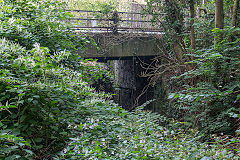
Tondu Ironworks Incline
|

Tondu Ironworks Incline
|
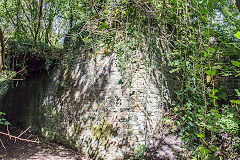
Tondu Ironworks Incline
|
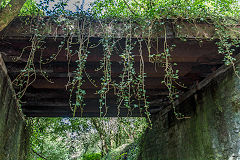
Tondu Ironworks Incline
|
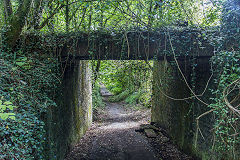
Tondu Ironworks Incline
|
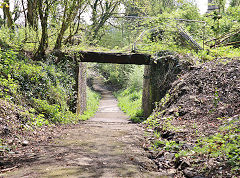
Tondu Ironworks Incline
|
|

Tondu Ironworks Incline
|
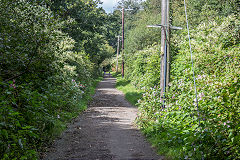
Tondu Ironworks Incline
|
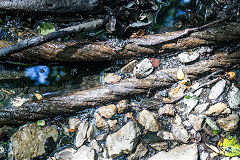
Tondu Ironworks Incline cable
|
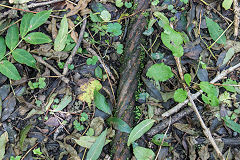
Tondu Ironworks Incline cable
|
Tondu House - SS 8875 8578
Tondu House Quarry - SS 8892 8512
Tondu House was an experimental site in WW2, the Pyrotechnic Research Establishment, aka Flame Warfare Research Establishment pyrotechnics. They built typical German buildings in the area to test their products out. There are a number of observation posts in the fields above the house. The quarry below Tondu House was also part of the WW2 experimental site. In the quarry is short length of 2' gauge track with a skip frame on top of which is a large block of concrete, behind which is a concrete wall on the side of the quarry. Apparently these were for testing explosives. Above the quarry is an observation post but I haven't found that yet.
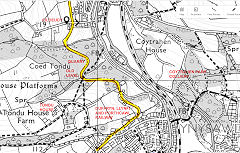
Coytrahen area
|
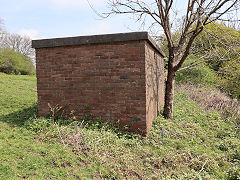
Tondu House observation bunkers
|
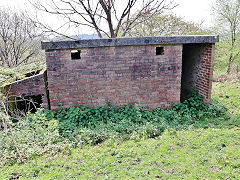
Tondu House observation bunkers
|
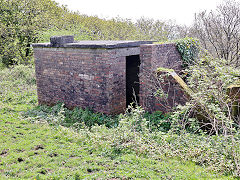
Tondu House observation bunkers
|
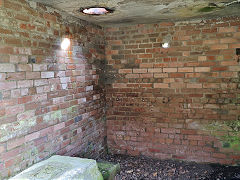
Tondu House observation bunkers
|
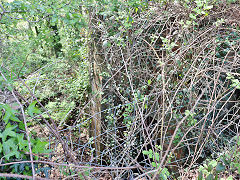
Tondu House observation bunkers
|
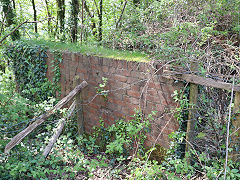
Tondu House observation bunkers
|
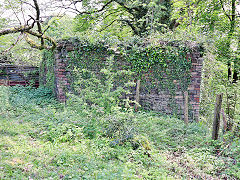
Tondu House observation bunkers
|
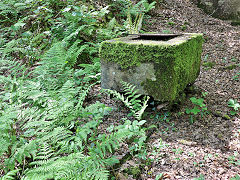
Tondu House quarry concrete block
|
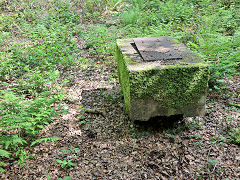
Tondu House quarry concrete block
|
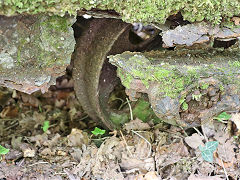
Tondu House quarry skip wheels
|

Tondu House quarry concrete block
|
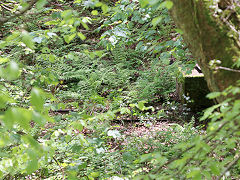
Tondu House quarry concrete block
|
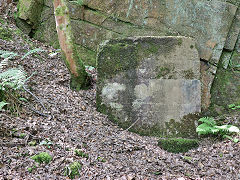
Tondu House quarry concrete wall
|
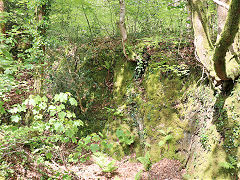
Tondu House quarry tramroad embankment
|
|
The Duffryn, Llynfi and Porthcawl Railway - SS 8892 8512
The Duffryn, Llynfi and Porthcawl Railway was a 4'6" tramroad open from 1825 to 1860. It was superceded by the Llynfi Valley Railway which took a route from Bridgend. This is the original route below Tondu House. The quarry was on this route as it looped round Tondu. The bridge abutments took spoil from a small level across the tramroad.
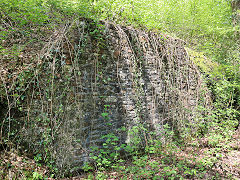
The DLPR bridge abutments
|
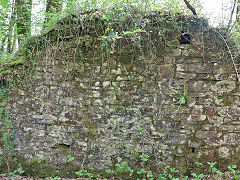
The DLPR bridge abutments
|
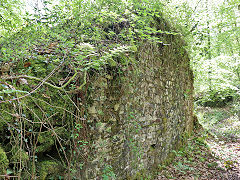
The DLPR bridge abutments
|
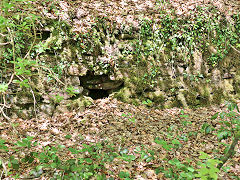
The DLPR below Tondu House
|
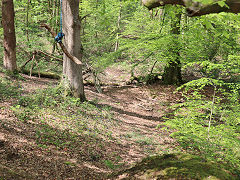
The DLPR below Tondu House
|
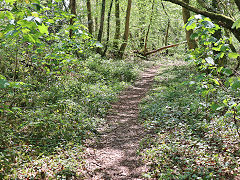
The DLPR below Tondu House
|
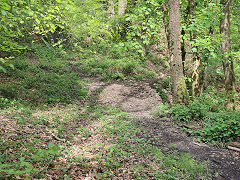
The DLPR below Tondu House
|
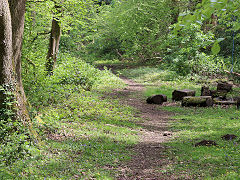
The DLPR below Tondu House
|
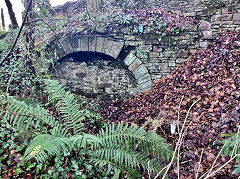
The DLPR tunnel at Cildaudy Lane
|
Sir Robert Price's Tramroad - SS 8903 8517
Sir Robert Price's Tramroad was a branch off the Bridgend Railway to Bettws Colliery along with a leat to Tondu Ironworks.

A small level beside the tramroad
|
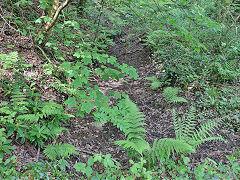
Sir Robert Price's leat
|
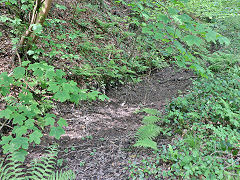
Sir Robert Price's leat
|
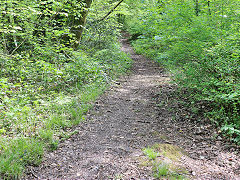
Sir Robert Price's Tramroad
|
Coytrahen Park Colliery, Tondu - SS 8974 8493
The 'Coytrahen Park Colliery Co Ltd' opened the colliery in 1906. It comprised of two separate levels, No 1 and No 2, but worked as one unit. The colliery closed on 1928 having employed nearly 400 colliers at one time. A small level re-worked the colliery for a few months in 1933.

Coytrahen area
|

Coytrahen Park Colliery, 1914
|
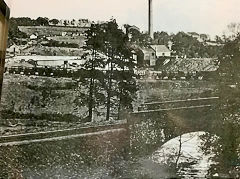
Coytrahen Park Colliery
|
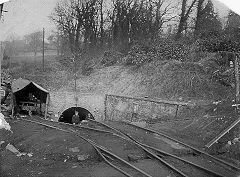
Coytrahen Park Colliery
|
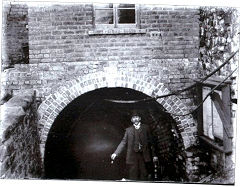
Coytrahen Park Colliery
|
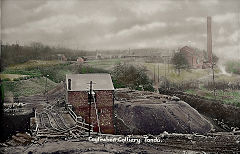
Coytrahen Park Colliery
|
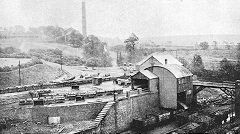
Coytrahen Park Colliery
|
|
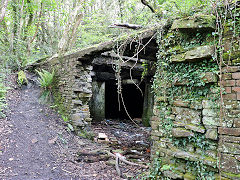
Coytrahen Park Colliery
|
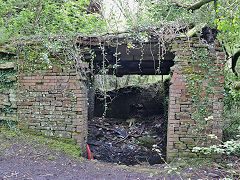
Coytrahen Park Colliery
|

Coytrahen Park Colliery
|
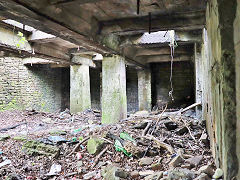
Coytrahen Park Colliery
|
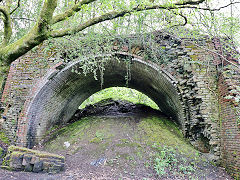
Coytrahen Park Colliery
|
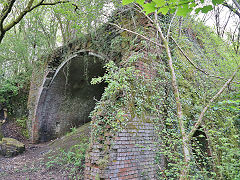
Coytrahen Park Colliery
|
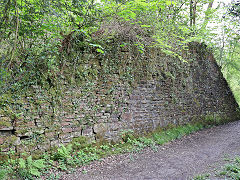
Coytrahen Park Colliery
|

Coytrahen Park Colliery
|
Acknowledgments, sources and further reading
Information from 'Coflein'
'Railways of the Llynfi Valley' by Clive Smith
A Guide to the Website
Industrial Wales
Collieries, Ironworks, Quarries, Railways, Canals, Tramroads, Tunnels, Culverts and so much more....
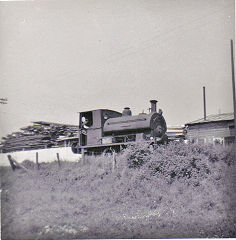
|
Brickworks of Wales
Bricks are 'History with a label' so here's the story of the Brickworks of Wales - photos, maps and the products themselves
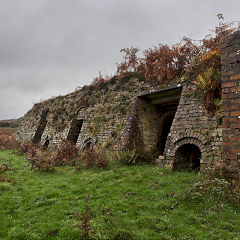
|
Around the World
My travels around the UK and the Whole Wide World in search of industries, railways, trams and mines to name a few.
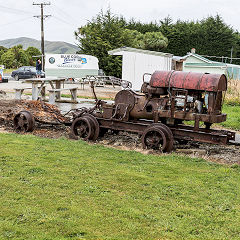
|
Iron and Stone
Boundary Stones, Mileposts and any kind of ironmongery from drain covers to builders plates.

|
Ships and Shipping
Ships around the World in simple alphabetical order of their name (or apparent area if I can't read the name).

|
The Site Map and Index
A full list of all the pages of the whole website in just one place, so you should find exactly what you are looking for.

|
About the Site
The background and technical details about the site, plus a contact page and links to other sites - and a warning !!
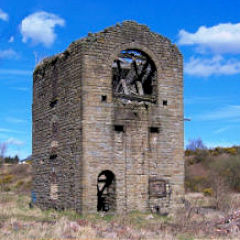
|
Contact Me
Something to add? A great photo? Something wrong? or need to know more about things? Just drop me a line here.

|
Further Reading
You can find lots of local and other very helpful websites, books, magazines and Facebook groups all listed here.
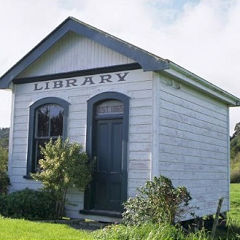
|
All rights reserved - Phil Jenkins
